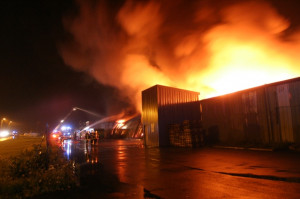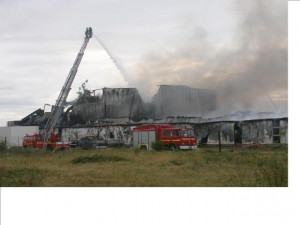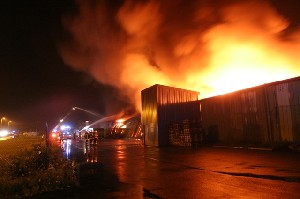A fire broke out at around 2.00 am in a 10,000 m² cake and confectionery manufacturing plant. The video surveillance company informed the maintenance manager. Around hundred fire-fighters arrived onsite with 27 fire engines. The fire-fighters cut off the gas and electricity supply, stopped traffic in the D9 by-road to pump water in a pond and brought the blaze under control at 6.00 am. Fire-fighters stayed back to monitor for any possible restart of fire. The mayor and staff from the press were on site. The retention tank and the pre-treatment station were full and thus could not hold the 200 m³/h of fire water. This flowed outside the site into a canal receiving rainwater from the site that drained into the OUDAN River. The rescue services set up a straw-bale dam. 90% of the plant was destroyed especially due to the presence of significant amounts of combustible material (sugar, flour, carton, etc.). The cooling units, functioning with R404a (mix of fluoroethanes) were impacted releasing hydrofluoric acid but the stocks (silos) of 60 m³ of sugar and 65 m³ of flour along with the hydrocarbon tanks and the site’s transformer remained intact. No victims were reported but the accident resulted in the technical unemployment of 120 people. On 01/08, the public water body management and surveillance authority detected no immediate impact on the canal. Appropriate resources will be deployed to treat the debris.
The soot and other material generated by the fire fell onto the neighbouring gardens and fields in a 3 km wide and 6 to 10 km long lane causing worry to the residents. The inspection authorities for classified facilities ordered the operator to carry out quality surveillance measurements in the zone south-east to the site likely to the impacted (total hydrocarbons, PAH, halogenated VOC, heavy metals, dioxin …). The results of the analysis of the soil and plants for human and animal consumption indicated levels below the threshold values but the canal water and sediments were contaminated by dioxin, PAH and heavy metals (Arsenic, lead and Zn). The results of the analysis carried out in January 2008 showed that the pollution of the water body, due to the fire of the plant, was cleared and that some of the pollutants detected previously are part of the background of the environment. The operator drafted a plan to assess the pollution impact on sediments and assess the environmental quality around the production site. The safety studies of the site did take into account a generalised fire in the site and planned measures to promptly control the fire which was not the case (15 h to extinguish the fire). The factory is rebuilt at the same place 18 months later at a cost of 15 Meuros: the establishment is equipped with a fire detection, sprinklers and a much bigger retention for firewater (840 m³). A short circuit in an electrical cabinet (installed in 1980) has triggered the fire.
Download the detailed report in .pdf format (576 Kb)






